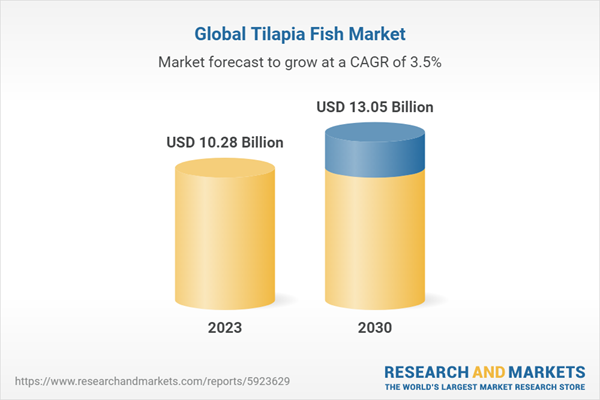Likewise, tilapia fish has achieved international popularity, becoming a culinary sensation for its moderate taste and flexible applications. Renowned for adaptability, tilapia prospers in various climates, contributing to its extensive cultivation. Its neutral flavor makes it a perfect canvas for numerous cuisines, appealing to diverse culinary preferences. The fish's affordability and quick boom further enhance its international appeal, helping sustainable aquaculture practices. With low mercury degrees, it emerges as a wholesome protein source. From upscale eating places to neighborhood markets, tilapia's presence on menus worldwide underscores its status as a loved and reachable seafood choice, connecting cultures via a shared gastronomic experience.
Global Tilapia Fish Market is projected to expand at a CAGR of 3.47% from 2024-2030
The burgeoning aquaculture sector considerably propels tilapia production, addressing worldwide seafood demands sustainably. Fueled by the need for increased fish protein without exacerbating overfishing, aquaculture’s-controlled environment optimizes tilapia breeding, fostering extended increases and better yields. This systematic approach ensures an extra sustainable supply chain. Technological strides in re-circulating aquaculture systems and selective breeding enhance performance and effective practices. The sector's expansion becomes a pivotal force, driving the exponential increase of tilapia production and securing a dependable and responsible supply of this famous and versatile fish for the worldwide market.Moreover, trade possibilities for tilapia have flourished due to expanding alternate agreements and globalization, growing new avenues for exports, and elevating its worldwide presence. The fish has become a key player in international markets, profiting from the inter-connectedness of economies. Also, organizations just like the Global Aquaculture Alliance are instrumental in promoting tilapia intake. Through strategic campaigns and recognition initiatives, these businesses contribute to an effective market perception of tilapia, fostering accelerated hobby amongst consumers worldwide. As a result, the fish transcends cultural obstacles, becoming a sought-after choice in various culinary landscapes and further solidifying its role as a staple in the global seafood market.
Besides, governments globally prioritize tilapia production through comprehensive aquaculture projects, recognizing its essential position in food protection and monetary boom. The 2020-launched Pradhan Mantri MatsyaSampada Yojana (PMMSY) allocates USD 1.4 Billion in funding to increase tilapia and standard fish manufacturing by 40% by 2024-25, offering subsidies for infrastructure, seed manufacturing, and training. The Blue Revolution Scheme provides monetary aid to tilapia farming infrastructure, while the Kisan Credit Card initiative offers low-interest loans for systems and inputs. These measures empower local farmers, stimulating rural improvement, diversifying protein sources, strategically reducing dependence on wild fisheries, reinforcing domestic food supplies, and fostering broader socioeconomic development. Hence, the global tilapia fish market was valued at US$ 10.28 Billion in 2023.
Indonesia is emerging as a worldwide leader in tilapia fish production due to strategic projects and favorable situations
Producing countries divide the Global Tilapia Fish Market into China, Indonesia, Brazil, Malaysia, Philippines, Vietnam, Thailand, Peru, Bangladesh, Colombia, Mexico, Costa Rica, and the United States. According to the Food and Agriculture Organization (FAO), Indonesia is presently the second largest tilapia manufacturer inside the global arena, simply in the back of China. The state's tropical weather helps year-spherical tilapia farming, making sure consistent yields. Government-backed programs promote sustainable aquaculture, offering farmers' subsidies, education, and infrastructure guides.Indonesia's huge community of rivers and ponds offers abundant freshwater assets perfect for tilapia cultivation. Moreover, the country's determination to assembly domestic demand and exploring international markets fuels growth. With a focus on modernizing farming practices and leveraging technology, Indonesia showcases a holistic technique, propelling its speedy ascent in worldwide tilapia production and securing a prominent role inside the thriving aquaculture industry.
Nile tilapia dominates the worldwide market because of its high-quality adaptability, speedy increase, and favorable flavor
By Species, the Global Tilapia Fish Market is fragmented into Nile, Tilapias nei, and Others. Originating in Africa, particularly the Nile River, this species thrives in diverse climates, permitting considerable cultivation. Renowned for its slight flavor, firm texture, and versatility in culinary applications, Nile tilapia appeals to various client alternatives. Its ability to tolerate varying water conditions and reproduce prolifically contributes to high yields and cost-effectiveness for farmers. Furthermore, Nile tilapia's extensive popularity in aquaculture structures globally, coupled with practical breeding applications, guarantees a constant supply. These factors together function Nile tilapia as the predominant and sought-after species within the thriving global tilapia market.Frozen fillet tilapia products dominate the global tilapia market size due to their comfort, versatility, and prolonged shelf life
By products, the Global Tilapia Fish Market is categorized into frozen whole tilapia, fresh tilapia, and frozen tilapia. Filleting eliminates bones, making sure a problem-free dining experience is attractive to consumers seeking convenience. Frozen fillets provide year-round availability, overcoming seasonal obstacles associated with sparkling fish. With cutting-edge freezing technologies preserving taste and texture, those products maintain quality throughout transportation, catering to global tilapia market price. Also, frozen fillet tilapia is a cost-effective alternative, making it handy for a broader customer base. The ease of guidance and suitability for various cuisines similarly solidify its reputation, organizing frozen fillet tilapia as a key participant in the thriving international tilapia market.Tilapia fish marketis dominated by United States
By Countries, the Global Tilapia Fish Market is broken up into United States, Canada, Germany, United Kingdom, France, Italy, Spain, Switzerland, Japan, China, India, Australia, South Korea, Indonesia, Mexico, Brazil, Argentina, South Africa, Saudi Arabia, United Arab Emirates, and Rest of world. The United States stands as a global powerhouse in tilapia consumption. Tilapia's affordability, adaptability in diverse culinary preparations, and comfort, available fresh or frozen meet the possibilities of budget-aware and busy consumers. The robust distribution networks of essential supermarkets, the giant presence of tilapia in the food service industry, and the upward push of direct-to-purchaser channels contribute to its significant availability. Favorable trade rules and agreements and health-conscious and sustainability-pushed consumer options enhance its market dominance. Industry tasks, retailer promotions, product innovation, and adherence to strict food protection requirements collectively solidify the United States as a dominant pressure in the global tilapia fish market.Key Players
High Liner Foods Inc., Surapon Foods, Thai Union Group, Grieg Seafood, and Charoen Pokphand Foods are prominent global tilapia fish market players.This research report provides a detailed and comprehensive insight of the Global Tilapia Fish Industry.
Producing Countries - Global Tilapia Fish Market breakup from 13 viewpoints:
- China
- Indonesia
- Brazil
- Malaysia
- Philippines
- Vietnam
- Thailand
- Peru
- Bangladesh
- Colombia
- Mexico
- Costa Rica
- United States
Species - Global Tilapia Fish Market breakup from 3 viewpoints:
- Nile tilapia
- Tilapias nei
- Others
Products - Global Tilapia Fish Market breakup from 3 viewpoints:
- Frozen Whole Tilapia
- Fresh Fillet Tilapia
- Frozen Fillet tilapia
Country - This Report Breakup from 21 Country Tilapia Fish Market
North America
- United States
- Canada
Europe
- Germany
- United Kingdom
- France
- Italy
- Spain
- Switzerland
- Asia - Pacific
- Japan
- China
- India
- South Korea
- Indonesia
- Australia
Latin America
- Mexico
- Brazil
- Argentina
Middle East & Africa
- Saudi Arabia
- United Arab Emirates
- South Africa
Rest of the World
All companies have been covered from 3 viewpoints:
- Overview
- Recent Development
- Revenue
Company Analysis
- High Liner Foods Inc.
- Surapon Foods
- Thai Union Group
- Grieg Seafood
- Charoen Pokphand Foods
Table of Contents
Companies Mentioned
- High Liner Foods Inc.
- Surapon Foods
- Thai Union Group
- Grieg Seafood
- Charoen Pokphand Foods
Methodology
In this report, for analyzing the future trends for the studied market during the forecast period, the publisher has incorporated rigorous statistical and econometric methods, further scrutinized by secondary, primary sources and by in-house experts, supported through their extensive data intelligence repository. The market is studied holistically from both demand and supply-side perspectives. This is carried out to analyze both end-user and producer behavior patterns, in the review period, which affects price, demand and consumption trends. As the study demands to analyze the long-term nature of the market, the identification of factors influencing the market is based on the fundamentality of the study market.
Through secondary and primary researches, which largely include interviews with industry participants, reliable statistics, and regional intelligence, are identified and are transformed to quantitative data through data extraction, and further applied for inferential purposes. The publisher's in-house industry experts play an instrumental role in designing analytic tools and models, tailored to the requirements of a particular industry segment. These analytical tools and models sanitize the data & statistics and enhance the accuracy of their recommendations and advice.
Primary Research
The primary purpose of this phase is to extract qualitative information regarding the market from the key industry leaders. The primary research efforts include reaching out to participants through mail, tele-conversations, referrals, professional networks, and face-to-face interactions. The publisher also established professional corporate relations with various companies that allow us greater flexibility for reaching out to industry participants and commentators for interviews and discussions, fulfilling the following functions:
- Validates and improves the data quality and strengthens research proceeds
- Further develop the analyst team’s market understanding and expertise
- Supplies authentic information about market size, share, growth, and forecast
The researcher's primary research interview and discussion panels are typically composed of the most experienced industry members. These participants include, however, are not limited to:
- Chief executives and VPs of leading corporations specific to the industry
- Product and sales managers or country heads; channel partners and top level distributors; banking, investment, and valuation experts
- Key opinion leaders (KOLs)
Secondary Research
The publisher refers to a broad array of industry sources for their secondary research, which typically includes, however, is not limited to:
- Company SEC filings, annual reports, company websites, broker & financial reports, and investor presentations for competitive scenario and shape of the industry
- Patent and regulatory databases for understanding of technical & legal developments
- Scientific and technical writings for product information and related preemptions
- Regional government and statistical databases for macro analysis
- Authentic new articles, webcasts, and other related releases for market evaluation
- Internal and external proprietary databases, key market indicators, and relevant press releases for market estimates and forecasts

LOADING...
Table Information
| Report Attribute | Details |
|---|---|
| No. of Pages | 270 |
| Published | January 2024 |
| Forecast Period | 2023 - 2030 |
| Estimated Market Value ( USD | $ 10.28 Billion |
| Forecasted Market Value ( USD | $ 13.05 Billion |
| Compound Annual Growth Rate | 3.4% |
| Regions Covered | Global |
| No. of Companies Mentioned | 5 |









